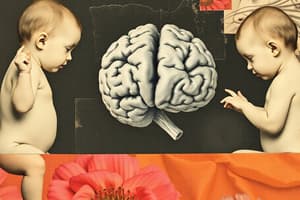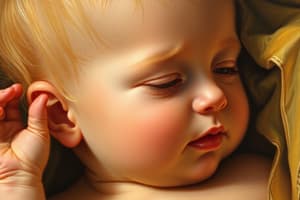Podcast
Questions and Answers
What happens to a newborn's blood volume right after birth?
What happens to a newborn's blood volume right after birth?
- Blood volume increases due to an influx of blood from the placenta before the umbilical cord is clamped. (correct)
- Blood volume decreases due to a loss of blood through the umbilical cord.
- Blood volume remains stable, but the composition of blood changes.
- Blood volume is not significantly affected.
What is the primary thermal stimulus that triggers the newborn's respiratory system?
What is the primary thermal stimulus that triggers the newborn's respiratory system?
- The sudden chilling of the infant's skin. (correct)
- The sudden influx of blood to the heart.
- The sudden increase in oxygen levels.
- The sudden decrease in pressure in the lungs.
Which of the following is NOT a factor contributing to heat loss in a newborn?
Which of the following is NOT a factor contributing to heat loss in a newborn?
- Conduction through contact with cold surfaces.
- Increased metabolic rate. (correct)
- Radiation from cooler objects.
- Evaporation of amniotic fluid.
When does a newborn typically start to produce drool?
When does a newborn typically start to produce drool?
During which stage of psychosocial development, according to Erikson, does a child develop a sense of competence and a desire to engage in activities that lead to a sense of achievement?
During which stage of psychosocial development, according to Erikson, does a child develop a sense of competence and a desire to engage in activities that lead to a sense of achievement?
What is the significance of the 'square window' assessment in a newborn?
What is the significance of the 'square window' assessment in a newborn?
What is the primary reason for administering Vitamin K to a newborn?
What is the primary reason for administering Vitamin K to a newborn?
During which stage of cognitive development, according to Piaget, does a child develop the ability to understand conservation, meaning they can recognize that the quantity of a substance remains the same even when its appearance changes?
During which stage of cognitive development, according to Piaget, does a child develop the ability to understand conservation, meaning they can recognize that the quantity of a substance remains the same even when its appearance changes?
What is the primary hormone that stimulates the production and secretion of follicle-stimulating hormone (FSH) and luteinizing hormone (LH) during puberty?
What is the primary hormone that stimulates the production and secretion of follicle-stimulating hormone (FSH) and luteinizing hormone (LH) during puberty?
What is the typical weight gain for an infant during the first 5-6 months of life?
What is the typical weight gain for an infant during the first 5-6 months of life?
At what age does an infant typically start to stand while holding onto furniture?
At what age does an infant typically start to stand while holding onto furniture?
Which of the following best describes the ability to think abstractly and hypothetically, as developed in Piaget's Formal Operational stage?
Which of the following best describes the ability to think abstractly and hypothetically, as developed in Piaget's Formal Operational stage?
Which of the following is a common challenge faced by adolescents during the Identity vs. Role Confusion stage, according to Erikson?
Which of the following is a common challenge faced by adolescents during the Identity vs. Role Confusion stage, according to Erikson?
What is the name of the reflex that causes a newborn to push their tongue out when something is placed in their mouth?
What is the name of the reflex that causes a newborn to push their tongue out when something is placed in their mouth?
Which of the following is NOT a characteristic of Piaget's Preoperational stage of cognitive development?
Which of the following is NOT a characteristic of Piaget's Preoperational stage of cognitive development?
What is the typical head circumference for a newborn?
What is the typical head circumference for a newborn?
In the process of puberty, how does the hypothalamus stimulate the production of FSH and LH?
In the process of puberty, how does the hypothalamus stimulate the production of FSH and LH?
What type of reasoning is characteristic of toddlerhood, where children draw conclusions from one particular event to another, even if they are not logically connected?
What type of reasoning is characteristic of toddlerhood, where children draw conclusions from one particular event to another, even if they are not logically connected?
At what age do toddlers typically begin to walk alone?
At what age do toddlers typically begin to walk alone?
Which of the following statements correctly describes the Tanner Stages of pubertal development?
Which of the following statements correctly describes the Tanner Stages of pubertal development?
Which of the following is NOT a source of stress commonly experienced by preschoolers?
Which of the following is NOT a source of stress commonly experienced by preschoolers?
What is the name of the stage in Freud's psychosexual theory that corresponds to the school-age years?
What is the name of the stage in Freud's psychosexual theory that corresponds to the school-age years?
Which of the following is NOT a common childhood injury as identified by the mnemonic 'SAFE PAD'?
Which of the following is NOT a common childhood injury as identified by the mnemonic 'SAFE PAD'?
Flashcards
Phallic Stage
Phallic Stage
Developmental stage from ages 3-6 where interest in genitals emerges and differences between sexes are explored.
Latency Stage
Latency Stage
Developmental stage from ages 6-12 characterized by energy focused on play, learning, and socialization.
Genital Stage
Genital Stage
Stage beginning at age 12 marked by puberty, where sexual tension and relationships become important.
Erikson's Trust vs. Mistrust
Erikson's Trust vs. Mistrust
Signup and view all the flashcards
Erikson's Autonomy vs. Shame
Erikson's Autonomy vs. Shame
Signup and view all the flashcards
Piaget's Sensorimotor Stage
Piaget's Sensorimotor Stage
Signup and view all the flashcards
Tanner Stages
Tanner Stages
Signup and view all the flashcards
Formal Operational Thought
Formal Operational Thought
Signup and view all the flashcards
Primary thermal stimulus
Primary thermal stimulus
Signup and view all the flashcards
Fetal circulation transition
Fetal circulation transition
Signup and view all the flashcards
Non-shivering thermogenesis (NST)
Non-shivering thermogenesis (NST)
Signup and view all the flashcards
APGAR score
APGAR score
Signup and view all the flashcards
Transition phase of assessment
Transition phase of assessment
Signup and view all the flashcards
Evaporation heat loss
Evaporation heat loss
Signup and view all the flashcards
Vitamin K function
Vitamin K function
Signup and view all the flashcards
Developmental milestone: walking
Developmental milestone: walking
Signup and view all the flashcards
Egocentrism in preoperational thought
Egocentrism in preoperational thought
Signup and view all the flashcards
Toilet training timeline
Toilet training timeline
Signup and view all the flashcards
Major developmental characteristics of vision
Major developmental characteristics of vision
Signup and view all the flashcards
Developmental growth in preschoolers
Developmental growth in preschoolers
Signup and view all the flashcards
Fears in preschoolers
Fears in preschoolers
Signup and view all the flashcards
Freud’s oral stage
Freud’s oral stage
Signup and view all the flashcards
Developmental milestones in feeding
Developmental milestones in feeding
Signup and view all the flashcards
Study Notes
Growth and Development (Immediate Adjustment)
- Respiratory System: Sudden chilling of an infant triggers sensory impulses in the skin, leading to respiratory adjustments.
- Circulatory System: Fetal circulatory system transitions to a postnatal system involving closure of fetal shunts (foramen ovale, ductus arteriosus, ductus venosus).
- Thermoregulation: Infants have a large body surface area, compensated by flexion to minimize exposed skin. This is because subcutaneous fat is thin leading to less body heat.
- Heat production: Infants cannot shiver, relying on nonshivering thermogenesis (NST) for heat production.
- Hematopoietic System: Blood volume (approx 80-85 ml/kg body weight) is established before clamping the umbilical cord.
- Fluid and Electrolyte Balance: At birth, infants have approximately 73% fluid, with a higher proportion of extracellular fluid.
- Metabolic Rate: Infants have a higher metabolic rate than adults, with increased acid formation leading to potential acidosis.
- Kidney Function: Immature kidneys cannot effectively concentrate urine to conserve water, making infants more prone to dehydration and acidosis.
GI System
- Liver Function: The liver is the least mature organ in the GI system at birth, with lower glycogen stores and a heightened risk of hypoglycemia.
- Salivary Glands: Salivary glands are not fully developed, and saliva production is delayed.
- Stools: First stool is meconium and transitional stools are greenish-brown to yellow-brown. Milk stools usually follow shortly after.
Renal System
- Kidney Function: Kidneys are not fully developed, decreasing the ability to concentrate urine. This makes infants more susceptible to dehydration.
- Bladder Capacity: The bladder volume is small at birth (about 15 ml), leading to frequent urination (approximately 20 voids daily).
Defenses Against Infection
- Antibody Production: Antibody formation requires exposure to antigens, allowing the infant to develop immunity over time.
Sensory Function
- Vision: Tear glands are not fully functional until 2-4 weeks of age. Eyes structurally incomplete.
- Hearing: Infants have a fully mature internal ear and middle ear at birth, able to distinguish sounds.
Assessment
- Four Phases of Assessment: Initial assessment, transitional assessment (during period of reactivity), full physical examination, using factors like heart rate, respiratory rate, muscle tone, reflex irritability, and skin color.
- APGAR Score: A scoring system (0-2 points each of Appearance, Pulse, Grimace, Activity, Respiration) is used to assess infants immediately after birth for difficulty breathing, and possible complications in the first minutes of life.
- Transitional Assessment: Immediately following birth, there is a transitional period with increased crying, and high heart rate and respiration rate, followed by a quieter stage of sleeping and calmness (2-4hrs)
Body Temperature
- Evaporation: Loss of heat through moisture (amniotic fluid or moisture on skin).
- Radiation: Loss of heat to cooler solid objects in the environment.
- Conduction: Direct contact of skin with cooler solid objects.
- Convection: Loss of heat with air currents.
Vitamin K Administration
- Function: Catalyzes synthesis of prothrombin in the liver of newborns. Important clotting factor.
Promoting Growth and Development (Proportional Changes)
- Growth: Infants experience rapid weight gain for the first six months, eventually doubling their birth weight. Height also increases. After 6 months, the rate of growth slows down.
- Locomotion: Infants demonstrate different developmental stages of locomotion by the end of the first year.
- Sensorimotor Changes: Development of depth perception that is not completely developed until 2-3 years old. Infants begin to understand that they can interact with objects in their environment after birth.
- Vision changes: Visual acuity will develop between one and several weeks after birth, and continues to improve throughout the first year of life.
Other key factors
- Common Infant Injuries: Potential dangers include suffocation, asphyxiation, burns, and poisoning
- Proportional Changes (Gross Motor Development): by 2 years old, birth weight has quadrupled.
Studying That Suits You
Use AI to generate personalized quizzes and flashcards to suit your learning preferences.




